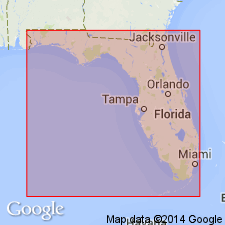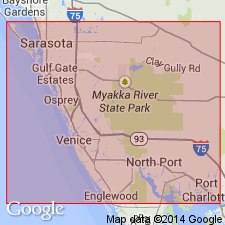
- Usage in publication:
-
- Fruitville
- Modifications:
-
- Not used
- AAPG geologic province:
-
- Florida platform
Summary:
Because Waldrop and Wilson (this volume) use biostratigraphic means to define their new "Fruitville Formation," the unit only adds to the existing confusion. Author maintains that according to the Code, a formation must be defined by lithostratigraphic characteristics and stratigraphic position.
Source: GNU records (USGS DDS-6; Reston GNULEX).

- Usage in publication:
-
- Fruitville Formation
- Modifications:
-
- Named
- Dominant lithology:
-
- Sand
- Clay
- Limestone
- AAPG geologic province:
-
- Florida platform
Summary:
"Fruitville Formation is a new name proposed here as a replacement name for the preoccupied Pinecrest Formation of Olsson (1964)." Name is from a small community located to the east of Sarasota. Unit occurs widely in southwest FL. Extends form Pinellas Park in Pinellas Co. to the Kissimmee River south of SR 60 in Polk Co. To the east, unit is cut into by the Pleistocene Bermont Formation and may be missing completely to the north of Miami. Rocks of the Fruitville in the Bird Road Pit in Miami were called Buckingham Formation, by Petuch (1986). Unit consists of sand, clay, and shell. Sand is the major nonbiogenic component. Fossil shells, both calcitic and aragonitic, are important biogenic components. At the stratotype in Macasphalt Shell pit, the Fruitville is approximately 18 ft thick. Disconformably overlies the Tamiami Formation and disconformably underlies the Caloosahatchee Formation. Elsewhere formation may be overlain disconformably by the Bermont or the Fort Thompson Formations. Age of the Fruitville is difficult to determine. A rough correlation exists between the Fruitville and the Jackson Bluff, Duplin, and Yorktown Formations. The minimum age of the Fruitville is less than 1.9 Ma based on land vertebrates. A maximum age span of from 5 to 1.9 Ma (Pliocene) is considered reasonable by the authors.
Source: GNU records (USGS DDS-6; Reston GNULEX).
For more information, please contact Nancy Stamm, Geologic Names Committee Secretary.
Asterisk (*) indicates published by U.S. Geological Survey authors.
"No current usage" (†) implies that a name has been abandoned or has fallen into disuse. Former usage and, if known, replacement name given in parentheses ( ).
Slash (/) indicates name conflicts with nomenclatural guidelines (CSN, 1933; ACSN, 1961, 1970; NACSN, 1983, 2005, 2021). May be explained within brackets ([ ]).

